Ever since I began working as a personal trainer, I have heard so many of my clients say: “I need to work on my conditioning”. Because of this, I’ve helped many people add conditioning workouts to their routine, and seen it make a huge difference in not just their physical fitness, but their overall lifestyle as well.
I’ve tried and tested many different conditioning workouts, taking note of things like my heart rate, calories burned, how I felt it built strength and muscle mass, and a whole lot more. Now, with a strong understanding of conditioning workouts, I am here to help!
Conditioning workouts are amazing for improving physical fitness, helping build strength, endurance, and flexibility in both the lower body and the upper body. Conditioning workouts can help you improve your cardio, build your abdominal muscles, and offer a wide range of general health benefits.
Whether you’re just starting your journey in fitness or are an experienced athlete, adding conditioning exercises to your routine can make a huge difference.
Who Should Try Conditioning Workouts?
The best part about conditioning exercises is that they are for everyone! Many beginners love to add conditioning exercises to their routine to build a solid fitness base, while the best athletes in the world still do them to enhance performance and lower the risk of injuries.
You can alter your conditioning workouts to match your level of fitness, and even for the top tier athletes, conditioning exercises will never get easy. They will help you push your limits in the best way possible.
Benefits for Each Group:
- Beginners: Helps develop basic endurance and learn proper exercise technique.
- Athletes: Improve sports-specific skills and performance.
- Fitness Enthusiasts: Break plateaus and increase workout intensity.
The Science Behind Conditioning Workouts

Conditioning workouts engage both aerobic and anaerobic energy systems, with the latter improving your core stability and providing short-term muscle strength and power.
Aerobic conditioning focuses on improving your cardiovascular endurance by using oxygen to meet the demands placed on your body during exercise. Think about how your body needs a lot of oxygen when you are running, conditioning workouts will help build your endurance for that.
Anaerobic conditioning, which includes activities like sprinting and high-intensity interval training (HIIT), improves short-term muscle strength and power without depending solely on oxygen. This is more about short and explosive exercises that make you strong!
Impact on the Body:
- Aerobic: Enhances heart and lung efficiency, increases stamina.
- Anaerobic: Builds muscle, enhances quick energy bursts.
Key Benefits of Regular Conditioning Workouts
Conditioning workouts come with a wide range of benefits for short-term and long-term fitness. They have been proven to enhance muscle endurance, help sustain muscle mass and improve your ability to perform physical tasks longer without feeling gassed.
I can personally say that conditioning exercises have made a huge difference in my strength training program and my long endurance workouts.
Here are some of the most significant benefits:
Improved Cardiovascular Health
- Heart Health: Regular conditioning workouts reduce the risk of heart diseases by improving blood circulation and decreasing blood pressure.
- Cholesterol Levels: This form of exercise helps in lowering the bad cholesterol (LDL) and increasing good cholesterol (HDL), helping you avoid serious cardiovascular health issues.
Improved Muscle Endurance
- Sustained Performance: Conditioning increases the efficiency of your metabolism, which means you can do more exercise for longer periods without feeling the need to tap out.
- Recovery Time: This one has been a game changer for me. Conditioning exercises improve your muscles ability to recover from workouts, which means you can workout more often and will avoid injury. Huge for athletes.
Fat Loss and Metabolic Benefits
- Increased Caloric Burn: High-intensity workouts, often a big part of conditioning sessions, will help you burn more calories and lose more weight!
- Metabolic Rate: Regular conditioning workouts boost your resting metabolic rate (RMR), meaning you burn more calories throughout the day even when you’re relaxing (i.e. sleeping, watching tv, etc.)
- Insulin Sensitivity: Conditioning will also improve the body’s response to insulin, decreasing the risk of insulin resistance and type 2 diabetes.
The 13 Best Conditioning Workouts You Can Do Today
As I said, I have tried and tested as many conditioning exercises as I can, not only for myself, but with clients as well. From these experiences, I have formed a list of the 13 best conditioning workouts you can add to your routine today to improve your fitness.
1. Burpees
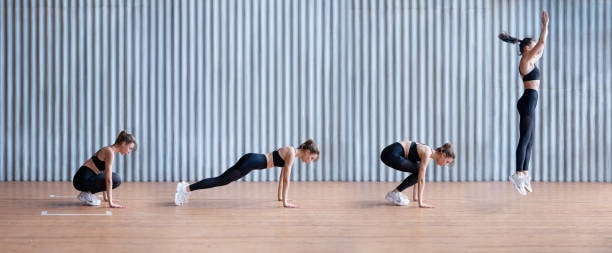
Burpees are a high-intensity full-body exercise that improves all facets of health: strength, endurance, and agility. These are simply the best conditioning workout you can do, and are a staple in many athletes lives.
How to:
- Stand with your feet shoulder-width apart.
- Squat down and place your hands on the floor in front of you.
- Jump your feet back to land in a plank position.
- Perform a push-up.
- Jump your feet back to the squat position.
- Explode up into a jump, reaching your arms overhead.
2. High Knees
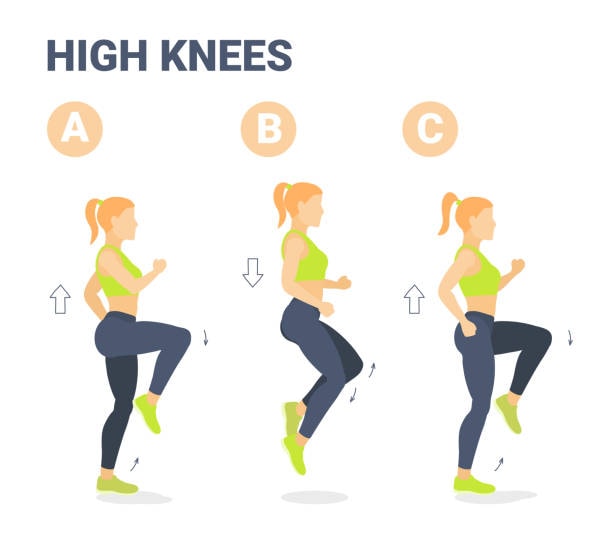
High knees combine running in place with exaggerated knee lifts, making it excellent for cardiovascular conditioning and lower body strength. If you are a runner, these are a must. When I was training for my marathon, I did plenty of high knees.
How to:
- Stand tall with your feet hip-width apart.
- Jog in place, lifting your knees as high as possible towards your chest.
- Pump your arms in sync with your legs.
- Maintain a fast pace to keep your heart rate up.
3. Jumping Jacks

Jumping jacks are a dynamic exercise that will increase your heart rate and improve your general cardio. These can be done super easily and are great calorie burners.
How to:
- Stand upright with your legs together and arms at your sides.
- Jump your legs out to the side while raising your arms above your head.
- Quickly reverse the motion by jumping back to the starting position.
4. Kettlebell Swings

Kettlebell swings target the glutes, hamstrings, core, and shoulders, building power and conditioning. For those who want to include some weight, this is the go-to move.
How to:
- Stand with feet slightly wider than hip-width, holding a kettlebell with both hands.
- Bend your knees slightly, hinge at your hips to push your buttocks back.
- Swing the kettlebell between your legs.
- Drive through your hips to swing the kettlebell up to chest height, straightening your legs.
- Let the kettlebell swing back between your legs and repeat.
5. Mountain Climbers
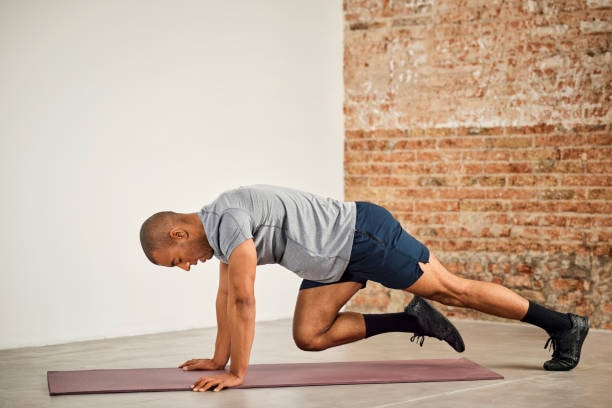
Mountain climbers are a compound exercise that boost cardio, core strength, and agility. This is a core burner for sure, and I promise you that no matter who you are, these will have you sweating.
How to:
- Start in a plank position with your hands under your shoulders.
- Drive your left leg and knee towards your chest without lifting your hips.
- Quickly switch, driving the other knee in while you extend the first leg back.
- Continue alternating quickly.
6. Battle Ropes
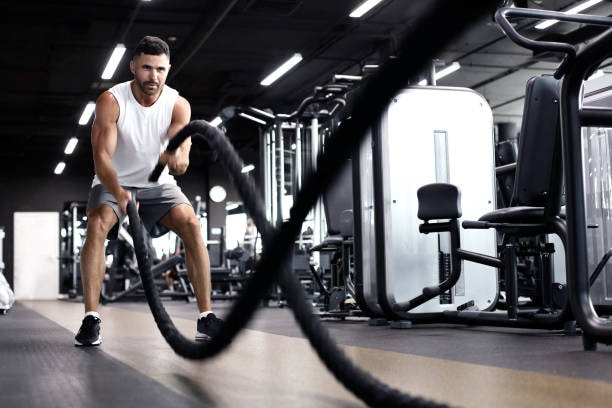
Battle ropes are a high-intensity, full-body workout that can really burn a lot of calories, while also improving strength levels in almost every part of your body. Another great one for athletes.
How to:
- Stand facing the anchor with feet shoulder-width apart.
- Grasp the ropes with both hands, slightly bend your knees.
- Alternate making waves with each arm; or simultaneously slam the ropes to the ground.
7. Jumping Rope

Jumping rope is an excellent cardiovascular workout that improves coordination, stamina, and agility. There’s no coincidence why this is a go-to for boxers, who are some of the best conditioned athletes in the world.
How to:
- Hold a jump rope’s handles with your hands.
- Swing the rope over your head and under your feet in a smooth motion.
- Jump slightly off the ground just enough to clear the rope under your feet.
- Maintain a rhythmic pace.
8. Medicine Ball Slams
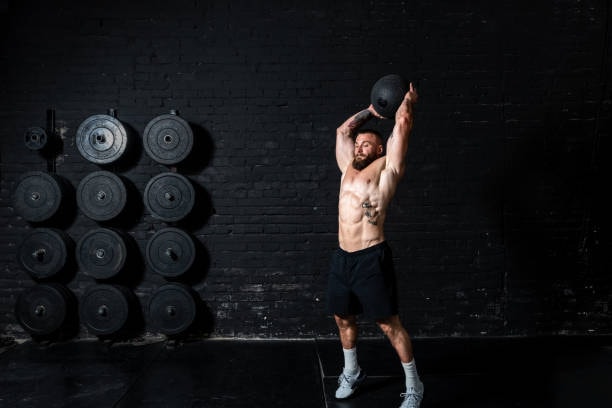
Medicine ball slams are great for developing explosive power and strengthening the core, shoulders, and back. These are great for athletes or those looking for explosiveness.
How to:
- Stand with your feet shoulder-width apart, holding a medicine ball overhead.
- Slam the ball down to the ground with full force.
- Squat to pick the ball up, lift it overhead, and repeat.
9. Squat Jumps

Squat jumps are a plyometric exercise that build explosive lower body strength and improve overall power. These are great to help you build that lower body power which will translate well to lifting weights.
How to:
- Stand with your feet shoulder-width apart.
- Perform a regular squat.
- Engage your core, and explode up into a jump from the squat position.
- Land softly and descend back into the squat to repeat.
10. Ice Skaters

Ice skaters simulate lateral movements, improving balance, agility, and leg strength. Phenomenal for athletes who do a lot of moving side to side.
How to:
- Leap to the right, landing on your right foot while sweeping your left foot behind you, but not touching the floor.
- Swing your arms in front of that bent knee for balance.
- Quickly jump to the left, reversing the leg and arm positions to mimic a skating stride.
11. Tire Flips
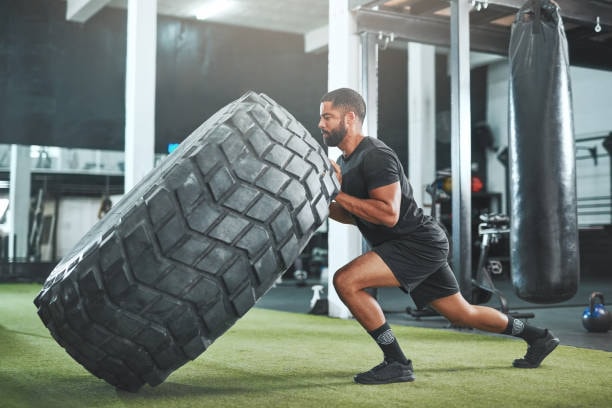
Tire flips are a classic exercise that improves strength, power, and endurance across the whole body. They are taxing, but will really help you build strength and stamina.
How to:
- Stand in front of a large tire with feet wider than shoulder-width.
- Squat down and grip the underside of the tire with both hands.
- Lift the tire by extending your legs while keeping your back straight.
- Push the tire forward and let it fall on the other side.
- Repeat the flip.
12. Sled Pushes

Sled pushes are a powerful exercise for building leg strength and cardiovascular stamina. I love doing sled pushes after a lift. I also think these help a ton for runners who want to build that lower body power.
How to:
- Load a sled with a weight appropriate for your fitness level.
- Stand behind the sled with both hands on the handles.
- Lean forward and drive the sled forward by walking or running.
13. Wall Balls
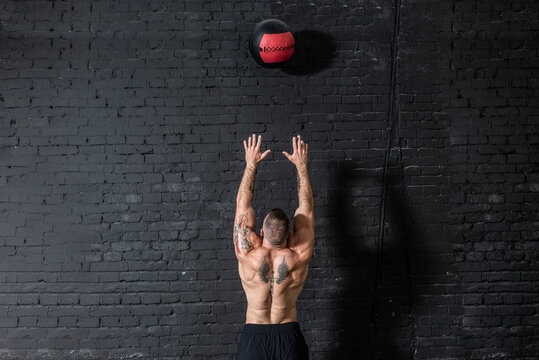
Wall balls are a dynamic, compound exercise that improves endurance and coordination. Another great compound movement to build the entire body and get it all working together.
How to:
- Stand a few feet from a wall with a soft medicine ball.
- Perform a deep squat while holding the ball at chest level.
- Explosively stand and throw the ball upwards to a spot on the wall.
- Catch the ball on the rebound and immediately go into the next squat.
Example Conditioning Workout Plans
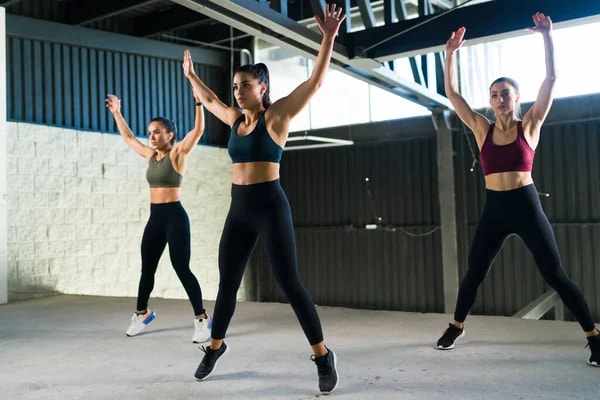
Here are some different conditioning programs you can try out depending on your level of fitness.
Beginner Plan
For those new to conditioning workouts, focusing on doing body weight exercises, building basic endurance and technique.
- Duration: 20 minutes per session
- Workout Routine:
- Jumping Jacks: 2 minutes
- High Knees: 1 minute
- Medicine Ball Slams: 2 sets of 10 reps
- Rest: 30 seconds between each exercise
- Repeat the circuit: 3 times
Intermediate Plan
For those who have some conditioning experience and are ready to increase the intensity.
- Duration: 30 minutes per session
- Workout Routine:
- Kettlebell Swings: 3 sets of 15 reps
- Battle Ropes: 3 sets of 30 seconds each
- Squat Jumps: 3 sets of 12 reps
- Rest: 45 seconds between each set
- Cycle through each exercise: Complete all sets of one exercise before moving to the next
Advanced Plan
For seasoned exercisers looking for a challenging routine to kick up their conditioning a notch.
- Duration: 45 minutes per session
- Workout Routine:
- Burpees: 4 sets of 15 reps
- Tire Flips: 3 sets of 10 flips
- Sled Pushes: 4 sets of 20 meters
- Rest: 1 minute between sets
- Cycle through each exercise: Perform all sets of one exercise before proceeding to the next
Each plan builds progressively, making sure that you can safely improve your conditioning by adjusting the volume and intensity according to your current fitness level. One step at a time.
Tips to Enhance Your Conditioning Workout Experience

Optimizing your conditioning workouts takes more than just following a routine. Here are some tips to help you improve your experience and achieve better results safely:
1. Proper Form
- Why It Matters: Maintaining proper form is the most important thing in order to prevent injuries and make sure that the targeted muscles are effectively engaged. Incorrect form can lead to strain and long-term damage.
- How to Maintain It:
- Educate Yourself: Before starting an exercise, make sure you understand how to do it. Watch instructional videos, read detailed guides, or work with a trainer to learn proper techniques.
- Self-monitor: Use mirrors to watch your form during exercises. This can help you make immediate corrections.
- Start Slow: Perform movements slowly at first to ensure your body understands the proper mechanics. Speed can be increased once form is mastered.
2. Adjust Intensity
- Individual Needs: Each person’s body responds differently to exercise, based on factors like age, fitness level, and health conditions.
- Customizing Your Workout:
- Scale Appropriately: Adjust the weight, speed, and volume of exercises to fit your current ability. As your strength and endurance improve, gradually increase the intensity.
- Listen to Your Body: Pay attention to how your body feels during and after workouts. If an exercise feels too challenging, modify it to an easier version or reduce the intensity.
Common Mistakes in Conditioning Workouts and How to Avoid Them

Even well-intentioned athletes can run into setbacks. Understanding these common pitfalls can help you avoid potential issues:
1. Overtraining
So many people do too much too fast, and burnout. That is one way to make working out no longer fun.
- Recognizing the Signs: Symptoms of overtraining include prolonged muscle soreness, elevated resting heart rate, fatigue, irritability, and decreased performance.
- Prevention Strategies:
- Rest and Recovery: Incorporate rest days into your training schedule to allow your muscles time to recover. Do both complete rest days and active recovery days where you engage in light activity, like walking. Read our article on the importance of rest and recovery for more.
- Periodization: Plan variations in training intensity and volume across weeks or months. This helps prevent the physical and mental burnout associated with overtraining.
2. Ignoring Pain
LISTEN TO YOUR BODY! Avoiding injuries at all costs is always going to be priority #1.
- Pain vs. Discomfort: While small discomfort is a natural part of fitness training, sharp or persistent pain is a warning signal from your body.
- How to Respond:
- Stop if Necessary: If you experience sharp pain during an exercise, stop immediately. Continuing to train through serious pain can lead to more severe injuries. There is no use for that.
- Seek Professional Help: Consult with a healthcare provider or a physical therapist if pain persists. They can offer diagnoses, treatment options, and modifications to your exercise regimen to prevent further injury.
FAQs on Conditioning Workouts

How often should I do conditioning workouts?
3-5 times a week, depending on intensity and personal fitness goals.
Can conditioning workouts help with weight loss?
Yes, they can significantly increase calorie burn and metabolic rate, which will make you lose weight a lot faster than you think.
Should I eat before a conditioning workout?
Yes, eating a light meal or snack that includes carbs and protein about 1-2 hours before your workout can help boost energy levels and prevent hunger during the session. Avoid heavy meals right before exercising to minimize discomfort.
Can conditioning workouts reduce injury risk?
Yes! Through a wide range of conditioning exercises, you can reduce injuries in the back, shoulder blades, legs, and by using them to build core strength, you will improve stability during strength training exercises as well.
Final Thoughts on Conditioning Workouts
Conditioning workouts have been a game changer for me and my clients, and they can be for you too. Adding a conditioning program to your routine will boost your physical fitness, improve your athletic performance and promote your long term overall health.
Whether you’re a beginner or looking to take your exercise routine to the next level, adding these kinds of workouts can lead to huge gains in your fitness journey. I know they have for me.

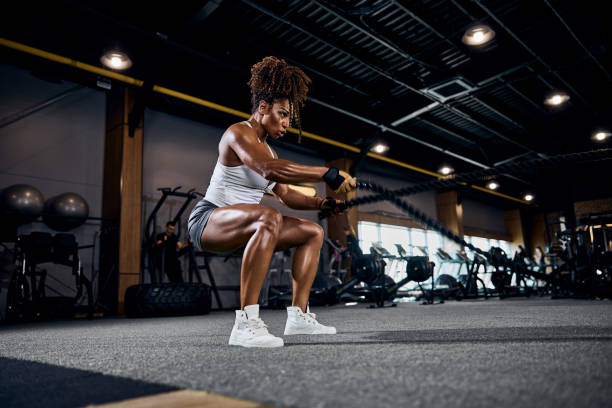











 Ever wondered how to build arms like Arnold?
Ever wondered how to build arms like Arnold? 
 Ready to build massive legs like the legend h
Ready to build massive legs like the legend h